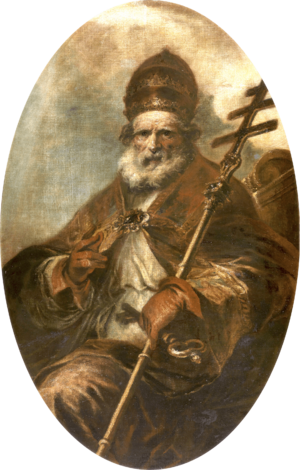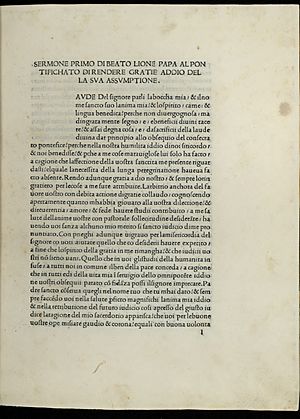Pope Leo I facts for kids
Quick facts for kids Leo I |
|
|---|---|
| Bishop of Rome | |

Miniature which depicts Leo I, contained in the Menologion of Basil II (c. 1000 AD, Vatican Library)
|
|
| Church | Catholic Church |
| Papacy began | 29 September 440 |
| Papacy ended | 10 November 461 |
| Predecessor | Sixtus III |
| Successor | Hilarius |
| Personal details | |
| Birth name | Leo |
| Born | c. 400 AD Tuscany, Western Roman Empire |
| Died | 10 November 461 (aged 60 – 61) Rome, Western Roman Empire |
| Sainthood | |
| Feast day |
|
| Venerated in | |
| Attributes |
|
| Other Popes named Leo | |
| Leo the Great | |
|---|---|

|
|
| Confessor, Doctor of the Church, Teacher of the Faith, Holy Hierarch, Bishop of Rome, Roman Pope | |
| Residence | Rome |
| Honored in | Catholic Church Eastern Orthodox Church Anglican Communion Lutheranism |
| Major shrine | Saint Peter's basilica |
| Feast | 10 November 3 (or 2) March |
| Influences | Augustine of Hippo |
Pope Leo I (around 400 AD – November 10, 461 AD) was the leader of the Catholic Church as the Bishop of Rome. He served from September 29, 440, until his death. He is also known as Leo the Great. Many people, including Pope Benedict XVI, believe his time as Pope was one of the most important in the Church's history.
Leo was a Roman noble. He was the first pope to be called "the Great." He is famous for meeting Attila the Hun in 452. He convinced Attila to turn back from invading Italy. Leo is also a Doctor of the Church. This title is given to saints who have made important contributions to Christian teaching. He is remembered for his writings, especially the Tome of Leo. This document was key in the discussions at the Council of Chalcedon. This important meeting helped define what Christians believe about Jesus Christ. Leo also helped shape the idea of the Pope's authority.
Contents
Early Life
Leo was born in Tuscany, a region in Italy. We don't know his exact birth year, but it was around 400 AD. By 431, he was a deacon. This means he was a church leader who helped the priests and bishops. He was well-known even outside of Rome.
Once, the Roman Emperor Valentinian III asked Leo to help settle an argument. This shows how much trust people had in Leo, even before he became Pope.
Papacy
While Leo was away on his mission, Pope Sixtus III died. On September 29, 440, Leo was chosen by everyone to be the next Pope.
When he became Pope, Leo quickly started working. He found out that some people were being allowed back into the church without fully giving up their old, incorrect beliefs. He stopped this practice. He made sure that people clearly stated they were giving up their old ways.
Leo also took action against groups like the Manichaeans. These groups had different beliefs from the Church. He held public debates with them. He also burned their books and warned other bishops about their teachings. He did the same against the Priscillianists in Spain.
Pope Leo also helped people in need. Rome was facing hunger and many refugees. He encouraged people to do good deeds and give to charity. During his time, the word "Pope" began to mean only the Bishop of Rome. Before that, any bishop could be called a "pope."
Papal Authority
Leo believed in strengthening the Pope's role in the Church. He wanted to make sure that the spiritual authority was centered in Rome. In 450, the Byzantine Emperor Theodosius II called the Bishop of Rome the "Patriarch of the West." This title showed the Pope's importance.
Church Matters in Different Regions
Leo often helped settle disagreements in the Church across different regions. For example, he was asked to help in Gaul (modern-day France). He made sure that the Pope's authority was respected. He even got a special order from Emperor Valentinian III. This order said that the Bishop of Rome had the highest authority. It also said that any bishop who refused to come to Rome when called could be forced to do so.
Leo also had disagreements with the leader of the Church in Alexandria, Egypt. Leo insisted that the Church in Alexandria should follow Rome's practices. He said this was because Mark the Evangelist, who founded the Alexandrian Church, learned from Saint Peter, just like Rome did.
He also wrote to bishops in Africa and Sicily. He told them to follow the rules and customs of the Roman Church. He stressed that only certain people should become bishops.
Leo also worked to keep the Church in Illyria (a region in the Balkans) connected to Rome. He sent instructions to the bishop there. He reminded him that "The care of the universal Church should come together at Peter's one seat." This meant that everything should be connected to the Pope in Rome.
Writings
We still have almost 100 sermons and 150 letters written by Pope Leo I. These writings help us understand his teachings.
The Tome
One of Leo's most famous writings is his Tome. This was a letter sent to Archbishop Flavian of Constantinople. It explained the beliefs of the Roman Church about Jesus Christ. At a meeting in 449, called the Second Council of Ephesus, Leo's letter was not read. The council made decisions that Leo disagreed with. Because of this, Leo and others did not accept that council.
Later, at the Council of Chalcedon in 451, Leo's Tome was presented again. It helped solve many arguments about Christ's nature.
Council of Chalcedon
The Council of Chalcedon was a very important meeting for the Church. It dealt with the teachings of Eutyches. Eutyches believed that Jesus did not have a true human nature. Leo strongly disagreed with this idea.
The Council of Chalcedon rejected Eutyches' teachings. It clearly stated that Jesus Christ has two natures: divine (God) and human. These two natures are united in one person, without being mixed up or separated. Leo strongly supported these decisions.
Teaching on Christ
Most of Leo's writings are about Jesus Christ. He wrote about who Jesus is and how he saves people. Leo taught that Jesus is both truly God and truly human. He defended this idea against those who believed only one side.
Leo also taught that Christ is present in the Church. He is present in the teachings, in the worship services, and in the lives of believers. Leo believed that the Virgin Mary's role was very important. She gave birth to Jesus, who was both human and divine.
Heir of Peter
Leo became Pope when barbarian invasions were increasing. The Roman Empire in the West was losing power. This meant the Bishop of Rome had to take a more active role in worldly affairs.
Leo was one of the first popes to strongly promote the idea of papal primacy. This means the Pope has the highest authority in the Church. He based this idea on the belief that the Pope is the successor of Saint Peter. Peter was one of Jesus's main followers and was seen as the first leader of the Church. Leo believed this was important for keeping the Church united.
Leo called himself the "heir" and "deputy" of Peter. He felt he had received Peter's authority and had to follow his example. He believed that Christ was the source of all grace and authority. Leo was responsible to Christ for how he led the Church.
Leo and Attila

In 452, Attila the Hun invaded Italy. His army was very powerful. He attacked cities like Aquileia and was heading towards Rome. The Roman Emperor sent three people to talk with Attila. Pope Leo was one of them.
We don't know exactly what was said during their meeting. But Attila decided to turn back and not attack Rome. Many historians believe Leo's actions were key to this success. Some stories say Attila was so impressed by Leo that he left. Another story says Attila saw a huge man in priestly robes, holding a sword, who threatened him if he didn't listen to Leo.
Leo's efforts could not stop the sack of Rome by the Vandals in 455. However, Leo and his clergy went to meet the Vandal king, Gaiseric. They begged him to spare the city from total destruction. While the Vandals did plunder Rome, Leo's influence helped prevent the city from being burned. It also ensured that important churches like St. Peter's were saved. After the attack, Leo helped rebuild Rome.
Death and Burial
Pope Leo I died on November 10, 461. He wanted to be buried as close as possible to the tomb of Saint Peter. So, his body was placed inside the portico of Old St. Peter's Basilica. He was the first pope to be buried inside St. Peter's. Later, his remains were moved to a more prominent spot inside the basilica.
Significance
Pope Benedict XIV declared Leo I a Doctor of the Church in 1754. This is a very high honor given to saints who have greatly contributed to Christian teaching. Only one other pope, Pope Gregory I, has also been recognized as a Doctor of the Church.
The Catholic Church celebrates Saint Leo's feast day on November 10. This is the day he died. The Eastern Orthodox Church celebrates him on February 18. He is also honored in the Church of England and the Episcopal Church.
Images for kids
-
Priest celebrating Mass at the Altar of Leo the Great in St. Peter's Basilica.
See also
 In Spanish: León I (papa) para niños
In Spanish: León I (papa) para niños
- Christology
- List of 10 longest-reigning popes
- List of Eastern Orthodox saints
- List of popes



